Blue Crabs at Night
Find better blue crabbing after sunset… no bait needed.
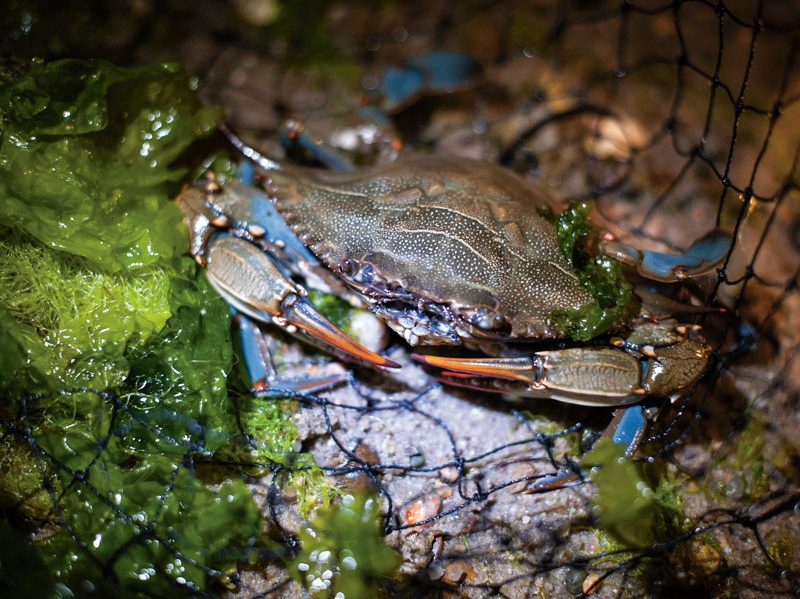
Pictured above: The blue crab’s scientific name, Callinectes sapidus, means savory, beautiful swimmer.
The pull-off at the end of the road is empty, as I expected it to be at 11:00 p.m. I open my trunk, pass over the rigged surf rod, and reach for the long-handled wooden net and bucket. Tonight is a crabbing night.
Once upon a time, my crabbing involved handlines and collapsible traps, frozen bunker, and rented tin boats. When the base of my crabbing operations moved from New Jersey to Cape Cod, I learned that these essential crabbing implements weren’t so essential up here. I toiled away in the marshes during the day for a few scant keepers while my co-worker, Andy Nabreski, filled buckets with delicious crustaceans. I tried different marshes, bays, ponds. I bought a commercial-grade crab pot and a permit for it and, still, a blue-claw feast eluded me. Eventually, Andy let me in on the secret—go at night.
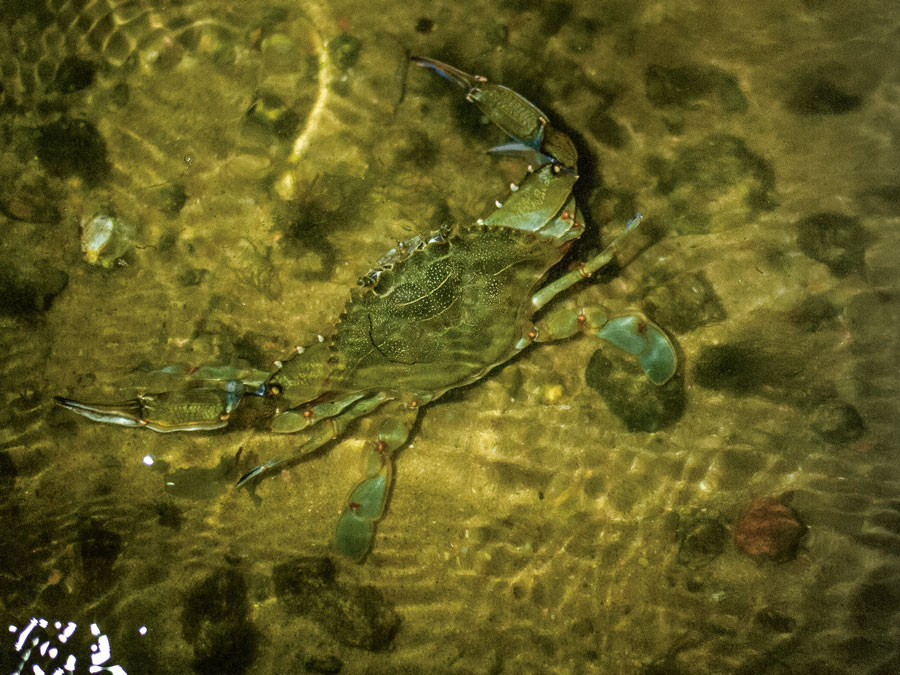
Crabbing at night wasn’t a thing in New Jersey, at least not that I knew of. That’s probably because New Jersey is closer to the blue-crab factory of the Chesapeake, and there’s a more robust population there than in New England, so daytime tactics produced just fine. I’ve since learned that nighttime crabbing is popular on Long Island and prohibited in Rhode Island—likely due to its effectiveness.
Andy’s approach to blue crabbing is surprisingly Spartan. He uses no boats, no traps, not even any bait. He hits the salt ponds with a net, a light, and a container for the crabs. His tactic couldn’t be simpler: illuminate a crab with the headlamp and scoop it with the net.
Blue crabs, like many predators, are more active after dark. They emerge from eelgrass and weeds where they hide during the day to scuttle close to shorelines and snatch spearing and mummichogs or scavenge fallen fish. This brings them into knee- to waist-deep water, often right against the shoreline or sod bank.
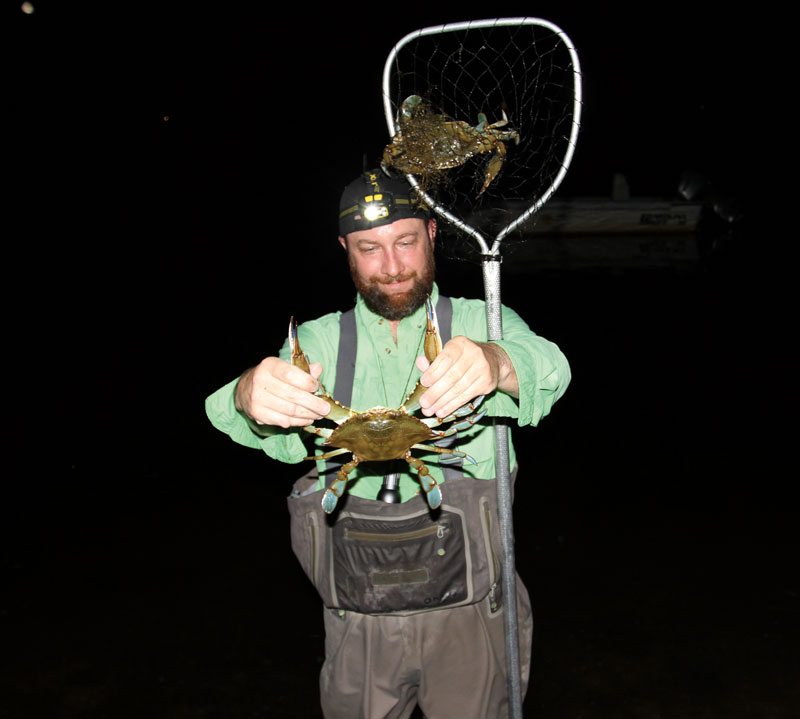
I silently cheer the lack of wind, which makes spotting the crabs easier, but my celebration is cut short by the feeling of a small chunk of my flesh being removed by a no-see-um. However, a few (or few hundred) bug bites are well worth it if the following evening finds me cracking shells in the glow of a citronella candle on my back deck.
I wade knee-deep into the water and flick on my headlamp. (I added a pair of fresh AAs before leaving the house because during a night of crabbing, the headlamp stays on the entire time.) I begin panning with the light and walk slowly along the shore. My pace is moderate – slow enough that I’m able to thoroughly scan the area, but not so slow that the silt and sediment I kick up drifts in front of me and affects my visibility.
The first crab appears almost immediately. Its olive-brown shell blends perfectly with the surrounding mud and vegetation, but its white “face” shines in the beam of my headlamp. Blue crabs have a “deer in the headlights” reaction at night, freezing as the light fixes on them. Only its mandibles move as it picks away at a smaller, deceased crab. With the bucket in my left hand, the net in my right, I slowly reach the net toward the crab, keeping my headlight directly on it. I get the net within a foot of the crab and it still hasn’t moved, so I jab forward, aiming for the bottom behind it, and quickly pull back. I can see the white of the crab’s bottom as it hits the mesh, and after assessing whether it is big enough that I don’t need to measure it, I flip the net over the bucket. I hear the scrabbling and clicking as the enraged crustacean scuttles about the bucket. I reach down and pull a glob of cabbage weed off the bottom and toss it into the bucket. The damp seaweed will keep the crabs calm and wet throughout my trip. Without sporadic layers of seaweed mixed in, the crabs would tear each other limb from limb…literally.
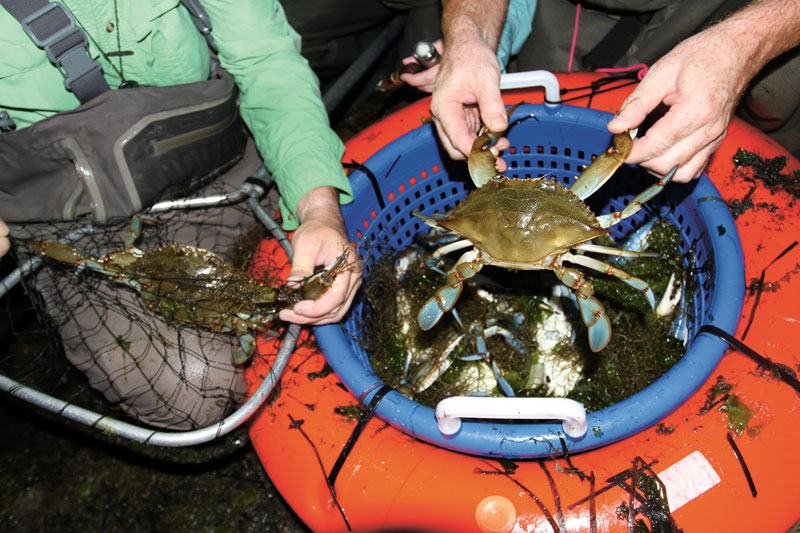
Blue crabs move very quickly from side to side, so the net has to be faster. I prefer to face the crab head-on, pulling the net from behind the crab toward me. I miss about one in three crabs on my first trip of the season, but by midsummer, my form perfected, I rarely miss any.
While the blue crab is the king crustacean from New Jersey south, in New England, it’s a distant second to the American lobster. For that reason, there are few crabbers to compete with in most Massachusetts backwaters. My main competition for the crabs on this particular salt pond is a river otter. In March, I saw a road-killed otter near the highway exit for my crabbing spot, and I secretly, guiltily, hoped it was him. It wasn’t. I approach a long-forgotten floating dock and see the evidence of his hunts strewn across the wooden slats. A dozen or more crabs—size limits and egg-bearing be damned—missing their backfin section, with claws—all that delicious meat in them—left to fester in the hot summer sun.
I add three more crabs to the bucket and prepare to scoop my fifth keeper when I spot the splash of red on the tips of the crab’s claws. A female.
There’s no good reason to keep female blue crabs, even the biggest ones. First, they have less meat because they lack the large, “lump” backfin meat of the males, and have smaller claws to boot. I was once told, at a roadside seafood shack in Southern New Jersey, that the female crabs have a sweeter meat, which is why they are used in the regionally popular she-crab soup. This isn’t exactly true. She-crab soup, when conceived in Charlestown, South Carolina, to impress a visiting President Taft, used the roe from a female crab to color and flavor it. Since keeping a female crab with a visible egg “sponge” is illegal, there is no good reason to harvest them. Leave them to continue to reproduce and keep your crabbing spots well stocked for future visits.
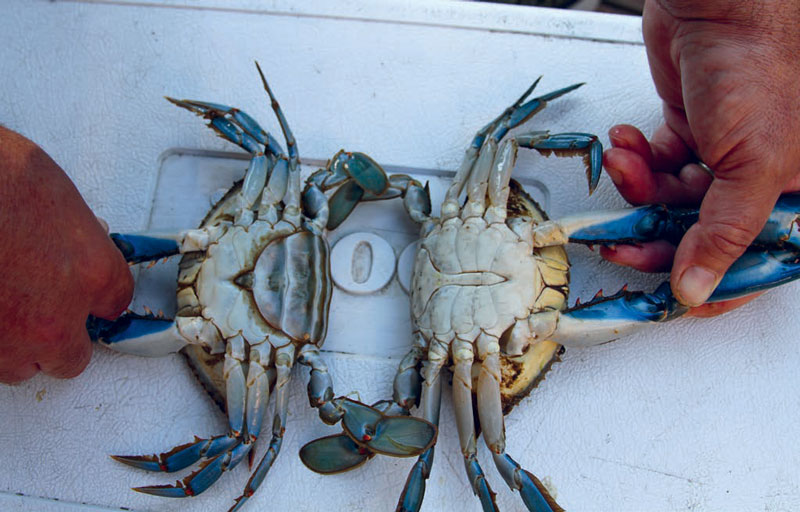
Many of the crabs I scoop are “rusty,” with shells tinged with brown and undersides scratched and discolored. This is a sign that it’s been awhile since the crab’s last molt and it’s likely to be heavy with meat. Crabs with green shells and snow-white bottoms have recently molted and have less meat inside their shells. When the crabbing is good, I set these crabs free, but when my bucket is light, I bring them home.
On this night, however, my bucket is heavy within an hour. The whole marsh is alive and active, above and below the waterline. In addition to blue crabs, I see eels, stripers, needlefish, spearing, blowfish, and thousands upon thousands of grass shrimp. I hear something in the reeds and see the eyeshine on a mink reflecting at me when I turn my head. A blue heron squawks angrily as my light disrupts its nighttime hunt.
I have a dozen crabs in the bucket when I decide to turn and head back, then I add five more by the time I reach the shore. Most are so big that I don’t need to measure them to know they meet the 5-inch point-to-point minimum size. A couple are close, though, and after gripping them firmly by the claws, I place them against the notches I made in my net handle to make sure they make the grade. The 17 crabs in the bucket are 8 shy of the bag limit but are enough to feed three of us for dinner, with enough left over for my lunch the following day.
To me, there’s no question about how to prepare crabs. I leave the crab cakes to the pros. I believe I’d be doing myself, and the crabs, a disservice by devoting several hours to catching, steaming, picking, assembling, and frying them for a couple minutes of eating. On a lazy summer afternoon, I vastly prefer it the other way around, with 15 minutes spent steaming and a couple hours spent picking and eating.
The next evening, we eat the crabs outdoors, with a roll of paper towels and a cooler of cold beer within arm’s reach of our seats. We each have a cup of melted butter for dipping the meat, but crabs steamed with equal parts water, apple cider vinegar, and beer are so flavorful that I often don’t want to dip it in anything.
By the time the sun starts to set, my lips are tingling from the gentle heat of the crab seasoning (J.O. #2, please), and the table in front of me is a tableau of spilled beer, fractured shells, and congealing butter. I sleep well that night, with the windows open, dreaming of a summer, and a crabbing season, that never has to end.
39 on “Blue Crabs at Night”
-
Peggy McCormick What a wonderful story. I used to catch them w/grandpa off seawall of our lake.Now do overfished . I wold love to go on an adventure like he described. For eating different boil in water
w/crab boil seasoning.i can send you some. Peggy-
Mary Nice story I moved to NC and I was so disappointed when I learned no blue crabs. So I found a sight and had some shipped Again a great big disappointment all females and so light. If you could ship me some please let me know your price for a 6 dozen
-
Angie Mary, Linton’s Seafood in Crisfield Maryland will ship you crabs catch from the bay. Google the phone number. Also, Southern Connection in Crisfield Maryland.
-
Brian I’m not sure what you mean by no blue crabs in NC. We get them all the time from the Cape Fear river area, Southport and Bald Head Island
-
Cherie Where in NC are you? I just moved from DC to NC so I’m use to eating blue crab every weekend during these warm months and things haven’t changed since I moved to NC. We either buy or catch blue crab and eat them every weekend. If you’re in an area that blue isn’t popular crabplace.com is a great place to order from.
-
Rob Mary being from Maryland i have crabbed all my life. When i was a kid the crabs were so plentiful and the bay was full of grass beds . we would walk along and we had a bushel basket in a tire intertube so it would float and the long handle net and hit the grass with it and the crabs would swim to the top to get away and we would dip them up and in the basket . we could fill it in no time . But having friends in NC we get crabs when we visit them . They are in New Bern. Which is near the water and the commercial crabbers catch and send them out of state . But take a trip to morehead city and get all the crabs you want.
-
Steven Deacon Yes I am a crabber from Maryland moved to corpus christi it illegal to crab after dark everywhere where are these guys from?
-
-
Steve There’s no lake crabs around here?
-
-
Marc As a guy who grew up in Maryland and now residing in Dallas, I miss Blue Crabs! They are difficult to find but occasionally an Oriental supermarket will have them. Loved the article.
-
Jason Asian not oriental
-
-
Sonya Love the story. I have blue crabs once a week. I use to go with my grandparents when I was younger with bait and a net. Those were the fun times. ?
-
Angelisa This made me smile remembering catching them with my Uncle on the Eastern Shore of Cambridge Maryland where I grew up. I am actually sitting down to.eat the few dozen.we bought home last night from Maryland.
-
Dan R Great story grew up spending summers on Chesapeake Bay crabbing with my cousin. Maybe we will try this if legal in Md
-
Shoe In the coastal bays in MD many years ago, we would boat slowly along the marsh in the evening and net them off the bank. Your story brought back those memories.
-
Richard Kutchinsky The crib place one line they ship all over the US
-
Mickey Awesome story! Great reading for crabbers and fishing romantics! Lol at the otter, he’s a hilarious character in the story!
-
Jayson I wish it was legal. We can only crab after sunset from private property. I miss those days.
-
Henry I enjoyed your story. I live in Augusta Ga and blue crabs are hard to find. I love blue crabs, wish they were more available here
-
Robert Sharp Great story. I’ve fished all over the US from marlin to large mouth bass. But by far my favorite thing to do and eat are blue crabs. I live on the Florida panhandle. We have a good population of blue crab. I find the the east coast and northern blue crab are heavier. Is that because of the colder water?
Tks -
Alex Jimmy. Can I ask where you go. We go to all the googled sites but they are over worked. We never come home with more than 2-3 keepers. I know people don’t want to give up their honey spots, but can you give a guy (and his two kids!) a a taste? Steelballer@gmail.com
-
Elizabeth Frake My dad would take my brother and I out on a small boat in the Barnegat Bay in Waretown New Jersey at night, My brother would drive the boat my dad would shine a light on the water and I would scoop up the crabs ! We did this many years ago good memories I will always hold my heart it was so much fun
-
Brenda I Love that story of your cabbing experience. As a child mine was very similar. Now we have to crab off piers. Wish I could find a crabbing spot. Like old times??
-
Sonny Great story that brought back fond memories. Years ago I used to work night shift. After work I’d go home, wake my wife and 2 young sons, and head to the jersey shore. My parents lived down the shore and we would meet my mom in Absecon and crab off the dock pilings by light.
-
andy mensing Jimmy,
Did you live year round “down the shore?” Every time I hear you, I hear
my boyhood friends from Germantown, Philadelphia where I grew up.
Stone Harbor, Cape May, Ocean City were my happiest places all year.
Crabs? Ha!! I didn’t eat them until I was in my 30’s. Like them even better than Lobsters. And butter? Vinegar wins by miles. (Aint no flies on crab cakes either.) Your beautifully written story makes me want to get out on the “wudder” with you some day. Calinectes Sapidus and a couple of jumbo IGFA Morone Saxatilis. And Jimmy Fee. A perfect day all around. -
Victor Great story only 2 things…. Female crabs only reproduce 1 time …. AND …. according to a 50 year commercial crabber from southern New Jersey female crabs do actually have more meat but they are harder to get it out of because it’s not in the back fin and claws like male crabs
-
Richard Redy I believe they only mate once but can drip eggs multiple times from that one encounter.
-
-
George Great article, how do you keep them fresh til the next night?
-
Michael O’Mara Great story. Just one comment. I’ve been seeing the word ‘deceased’ used more and more in reporting. This may be because it’s considered a ‘kinder, gentler’ term when referring to human death. But c’mon, it’s a DEAD crab.
-
Paul V. Hey Andy, My first sight of blue crabs were back in June 1965. My folks took out a place for two weeks on the upper stretches of Bass River where it fans out like a lake. The cottage had a small beach of sorts, but it was really just a marsh clearing. My sister and I were wading in boots….looking for nothing in particular. I clearly recall seeing something big in the weeds where it was about waist deep. I poked it with my long stick and it turned out to be a very large crab that took off sideways.
Back then, there was much less pressure on crabbing than we have today. As a result, the crabs were more numerous and larger. I forgot how we got started in trapping them, but I spent the better part of my vacation going after crabs in our area. The cottage had some long nets and other crab gear. Dad called the owner for permission to use his gear….the man came down in a flash and was delighted to show me how to go about it right proper. He and I went out for several nights thereafter catching some impressive sized crustacea….very good sizes, in fact. I still recall my first taste of those crabs done up in a simple steamed method as well as his (Azorean) boil.
That cottage is still there as well as the owner despite his age. We keep in regular touch and I pursue blue crabs to this day with a net….I like that sporting aspect.
-
Mike Guyader We used to go crabbing at night off an old rail road pier on the Barnegat Bay near Island Beach back in the 1960s and ’70s. We would set Coleman gas lanterns out on the end of the cross piles at dusk and wait for the crabs to swim by. Most of us used nets on the end of 8′ to 10′ poles. The largest crabs would be found at the edge of the lamp’s light arc. Some nights we could fill a bushel basket in less than 2 hours. NJ made this variation of crabbing illegal some years ago. Will give it a try this coming summer. Looking forward to it!
-
Christopher Tyrrell E
-
Paul Oliver Fantastic story, but you lost me with the J.O…..its all about the Old Bay
-
Smokey Crab hunter How is and best place to go crabbing in Florida?We are going to Destin next week.
-
Stephen Ches J.O. and old bay mixed 50/50 is the best seasoning. And who in their right mind, boils blue crabs?
-
Heinz Except for the shoutouts to your location, you could’ve been talking about South/Coastal Georgia or Florida.
-
chaos504 (Crabbing at night is illegal in Louisiana.) Lake Pontchartrain is prime, with blue crabs of unsurpassed quality – well, maybe not for the years right after the Deepwater Horizon fiasco. Enjoy the crustaceans while you can.
Leave a Reply